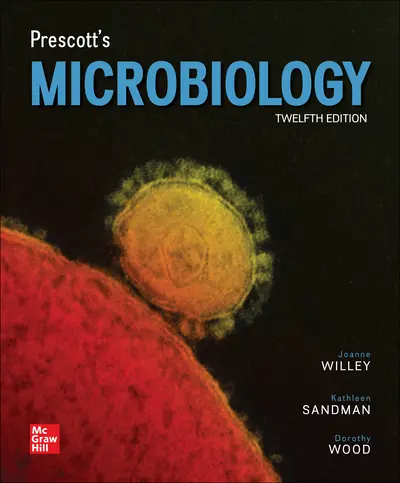My Account Details

ISBN10: 1264088396 | ISBN13: 9781264088393

* The estimated amount of time this product will be on the market is based on a number of factors, including faculty input to instructional design and the prior revision cycle and updates to academic research-which typically results in a revision cycle ranging from every two to four years for this product. Pricing subject to change at any time.
Instructor Information
Quick Actions (Only for Validated Instructor Accounts):
The author team of Prescott’s Microbiology continues to provide a modern approach to microbiology by using evolution as a framework. With an impactful introduction to the entire microbial world covered in separate chapters on the structure and function of bacteria and archaea which is followed by the discussion of eukaryotic cells and viruses. You will also find a broad coverage of microbial ecology which is demonstrated by content that ranges from global climate change to the human microbiome.
Chapter: 1. The Evolution of Microorganisms and Microbiology
Chapter: 2. Microscopy
Chapter: 3. Bacterial Cell Structure
Chapter: 4. Archaeal Cell Structure
Chapter: 5. Eukaryotic Cell Structure
Chapter: 6. Viruses and Other Acellular Infectious Agents
Part Two Microbial Nutrition, Growth, and Control
Chapter: 7. Bacterial and Archaeal Growth
Chapter: 8. Control of Microorganisms in the Environment
Chapter: 9. Antimicrobial Chemotherapy
Part Three Microbial Metabolism
Chapter: 10. Introduction to Metabolism
Chapter: 11. Catabolism: Energy Release and Conservation
Chapter: 12. Anabolism: The Use of Energy in Biosynthesis
Part Four Microbial Molecular Biology and Genetics
Chapter: 13. Bacterial Genome Replication and Expression
Chapter: 14. Regulation of Cellular Processes
Chapter: 15. Eukaryotic and Archaeal Genome Replication and Expression
Chapter: 16. Mechanisms of Genetic Variation
Chapter: 17. Microbial DNA Technologies
Chapter: 18. Microbial Genomics
Part Five The Diversity of the Microbial World
Chapter: 19. Archaea
Chapter: 20. Nonproteobacterial Gram-Negative Bacteria
Chapter: 21. Proteobacteria
Chapter: 22. Gram-Positive Bacteria
Chapter: 23. Protists
Chapter: 24. Fungi
Chapter: 25. Viruses
Part Six Ecology and Symbiosis
Chapter: 26. Exploring Microbes in Ecosystems
Chapter: 27. Microbial Interactions
Chapter: 28. Biogeochemical Cycling and Global Climate Change
Chapter: 29. Microorganisms in Marine and Freshwater Ecosystems
Chapter: 30. Microorganisms in Terrestrial Ecosystems
Part Seven Pathogenicity and Host Response
Chapter: 31. Innate Host Resistance
Chapter: 32. Adaptive Immunity
Chapter: 33. The Microbe-Human Ecosystem
Chapter: 34. Infection and Pathogenicity
Part Eight Microbial Diseases, Detection, and Their Control
Chapter: 35. Epidemiology and Public Health Microbiology
Chapter: 36. Clinical Microbiology and Immunology
Chapter: 37. Human Diseases Caused by Viruses and Prions
Chapter: 38. Human Diseases Caused by Bacteria
Chapter: 39. Human Diseases Caused by Fungi and Protists
Part Nine Applied Microbiology
Chapter: 40. Microbiology of Food
Chapter: 41. Biotechnology and Industrial Microbiology
Chapter: 42. Applied Environmental Microbiology
Appendix 1 A Review of the Chemistry of Biological Molecules
Appendix 2 Common Metabolic Pathways
Appendix 3 Microorganism Pronunciation Guide
Accessibility
Creating accessible products is a priority for McGraw Hill. We make accessibility and adhering to WCAG AA guidelines a part of our day-to-day development efforts and product roadmaps.
For more information, visit our accessibility page, or contact us at accessibility@mheducation.com
Affordability
Reduce course material costs for your students while still providing full access to everything they need to be successful. It isn't too good to be true - it's Inclusive Access.
Need support? We're here to help - Get real-world support and resources every step of the way.